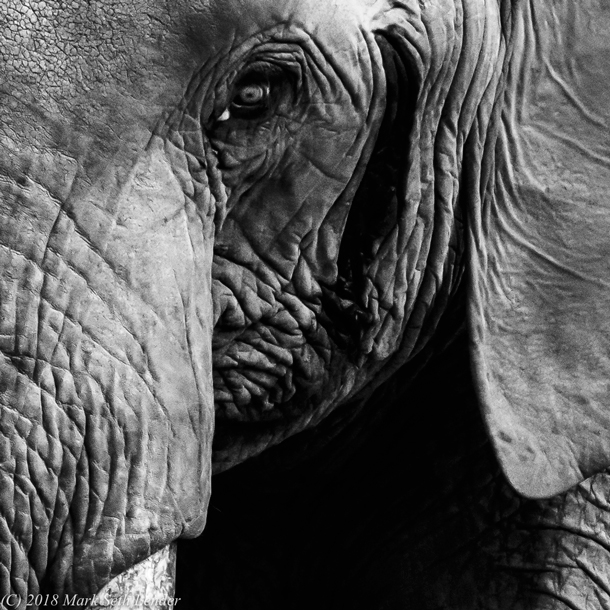Field Note: Fearsome Bull Elephant Musth
Published: April 14, 2019
By Mark Seth Lender

A close-up of an African Elephant. (Photo: Courtesy of Mark Seth Lender)
Living on Earth's Explorer in Residence Mark Seth Lender reflects on witnessing a bull elephant when he comes into musth, and becomes a force of nature that demands respect.
Bull elephants become sexually active at about twenty years of age. By that time they have been adults for a while, gathered in groups of their own gender orbiting the same general territory as the main herds composed of juveniles of both sexes, and ruled by adult females. The bulls are usually placid, in my experience more so than the females who, after all, have greater responsibilities and concerns. Placid, that is, until they come into musth, the testosterone-fueled urge to mate. When that happens they become a force of nature.
Elephants know how big they are. This is a good thing. A black mamba is apt to inform you of your excessive proximity by striking the middle of your chest. The mamba is on a short fuse. I think at least in part because while good-sized as snakes go, the mamba is small as compared to you. Mambas take no chances. An elephant on the other hand has the luxury of being able to warn you first.
However, if poachers have murdered one of the members of the herd, elephants become vengeful, as humans would be in similar circumstances. When you hear of someone (tourist or professional) killed deliberately by an elephant who came up on them from behind or otherwise unannounced, that is the likely backstory. Always pay more attention to what the elephant wants than what you want.
What was charming about our bull in musth is he enjoyed it. He enjoyed pushing us back. If he wasn’t puffing himself up, why did he bother, showing us what he knew we knew already. That he had right of way, that he was The Boss. After all, he and his penis had in their collective intention other plans. We were a sideshow.
So again: He must have enjoyed it.
So did I.
Hear Mark Seth Lender read this essay
Back to Mark Seth Lender Field Notes
Living on Earth wants to hear from you!
Living on Earth
62 Calef Highway, Suite 212
Lee, NH 03861
Telephone: 617-287-4121
E-mail: comments@loe.org
Newsletter [Click here]
Donate to Living on Earth!
Living on Earth is an independent media program and relies entirely on contributions from listeners and institutions supporting public service. Please donate now to preserve an independent environmental voice.
NewsletterLiving on Earth offers a weekly delivery of the show's rundown to your mailbox. Sign up for our newsletter today!
 Sailors For The Sea: Be the change you want to sea.
Sailors For The Sea: Be the change you want to sea.
 The Grantham Foundation for the Protection of the Environment: Committed to protecting and improving the health of the global environment.
The Grantham Foundation for the Protection of the Environment: Committed to protecting and improving the health of the global environment.
 Contribute to Living on Earth and receive, as our gift to you, an archival print of one of Mark Seth Lender's extraordinary wildlife photographs. Follow the link to see Mark's current collection of photographs.
Contribute to Living on Earth and receive, as our gift to you, an archival print of one of Mark Seth Lender's extraordinary wildlife photographs. Follow the link to see Mark's current collection of photographs.
 Buy a signed copy of Mark Seth Lender's book Smeagull the Seagull & support Living on Earth
Buy a signed copy of Mark Seth Lender's book Smeagull the Seagull & support Living on Earth

